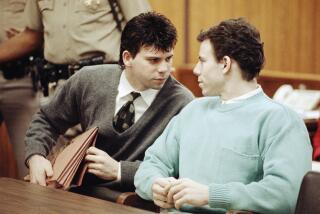Flashlight Feud Casts a Shadow
- Share via
They called it the world’s best flashlight, a plastic torch so bright it could illuminate the gloomiest of caves or the darkest mountain trail on a moonless night.
Through clever engineering, brothers Stephen and Christopher Halasz claimed to have solved the eternal puzzle of the “black hole”--that dark spot that appears in the center of flashlight beams. Their Bison Sportslight, they said, surpassed even the legendary Maglite, the black aluminum icon of flashlights and the industry standard for more than a decade.
The Maglite was not just any competitor. Its inventor, Tony Maglica, was a father figure to the brothers and their mother’s live-in companion for more than 20 years. The Halasz brothers grew up idolizing Maglica and followed him into the flashlight business.
The relationship was shattered when their mother broke up with Maglica and sued him for $200 million in palimony. So when the brothers formed their own company to develop a rival flashlight five years ago, Maglica declared war.
“I felt betrayed,” said Maglica, 72. “I raised these boys for much of their lives. I paid for all their education. What happened here I wouldn’t expect in a million years to happen.”
Out of this family feud came a business fraud lawsuit that is part physics lesson and part soap opera. It pitted two upstarts against a man considered by many the Bill Gates of the flashlight industry.
Maglica says he went to court to protect Maglite’s reputation as the top dog of flashlights and to debunk the brothers’ claim that they had eliminated the irksome “black hole.”
But Stephen Halasz sees a more personal motive. “A lot of what’s going on here is just residual bitterness from the battle he had with my mother,” he said. “I always thought Tony and my mother would be able to work things out.”
*
It was little more than a decade ago that Maglica and the Halasz brothers were sharing meals together at Maglica’s Anaheim Hills home and working side-by-side at the Mag Instrument factory in Ontario, where workers turned out flashlight cases on enormous industrial lathes.
Maglica had lived with the brothers’ mother, Claire, since the early 1970s. She was an interior designer whom Maglica had hired to decorate his machine shop. Although they weren’t married, Claire took Maglica’s last name, and they were known as husband and wife to Orange County’s social and political elite.
Hobnobbing with presidents Ronald Reagan and the elder George Bush, the couple became generous patrons of the Republican Party and made headlines in 1993 when they financed the rescue of a blind boy, his mother and his sister from Bosnia and brought the boy to California for medical care.
Tony Maglica was born in New York, but grew up on a small island off the coast of Yugoslavia. He returned to the United States in 1950 and went to work in a machine shop in California. He went into business for himself a few years later, making precision tool parts in his Ontario garage.
After churning out machine parts for the aerospace industry and the military, Maglica produced his first premium flashlight in 1979. Heavy, well-machined and sleekly styled, the device was an instant hit with police officers, who loved its superior illumination and shell of aircraft-grade metal.
“The Maglite revolutionized field police work,” said Roy Huntington, a former San Diego cop and editor of American Handgunner, a magazine for firearms enthusiasts. “You could use it to bash out the side window of a car or a cretin on the head.”
The Maglite became as standard a piece of equipment as an officer’s handcuffs and revolver.
“You could always tell a veteran street cop by his flashlight,” Huntington said. “They’d have nicks and dents where an officer had used it to bash open a door or had dropped it off a roof in a scuffle. It was a mark of office.”
The flashlight spread to the general public, particularly when the company introduced the smaller Mini Maglite. The privately held company now has more than 800 employees and had sales of nearly $70 million last year.
The Halasz brothers shared in Maglica’s success and basked in his affection. He regarded them as sons, and they regarded him as their stepfather.
The brothers accompanied Maglica when he unveiled the first Maglite at an industry trade show in Las Vegas in 1980. On their summer breaks from high school and college, Maglica taught them the business from the ground up.
Claire Maglica also worked for Mag Instrument, running the company’s personnel, marketing and purchasing operations from a desk next to Maglica’s.
When the Halasz brothers finished graduate school, Maglica gave them positions of responsibility in his company. Christopher, now 45 and an engineer, worked as Mag’s director of research and development. Stephen, now 47, was a vice president and later Mag’s outside legal counsel.
Maglica said they were privy to the company’s most guarded secrets.
“I trusted Stephen with all my personal information,” Maglica recalled. “He knew everything about me, like a doctor.”
Tony and Claire’s relationship ended abruptly in 1992. She learned that he planned to leave the company to his children from a previous marriage. She confronted him.
“He said, ‘What business is it of yours?’ I said, ‘I’m your wife,’ and he said to me, ‘You got a piece of paper to prove it?’ ” Claire Maglica later recounted in court. “I said, ‘If I’m not your wife, then what am I?’ He said, ‘You’re my employee.’ ”
The rift developed into a bitter palimony suit that was televised nationwide on Court TV. Claire insisted that she had helped build up Mag Instrument from a hole-in-the-wall machine shop to an internationally known company.
The sons were caught in the middle. Stephen Halasz never again handled any of the company’s legal work. Christopher Halasz, too, soon left the firm.
“He was left in an office where no one would talk to him,” his brother said. “The other employees were terrified to be seen with him. Our side of the family was out.”
In 1994, a jury in Santa Ana awarded Claire $84 million in palimony, but an appeals court overruled the decision. In 2000, she settled for $29 million.
*
With their ties to Mag Instrument severed, the Halasz brothers decided to start their own flashlight business near Denver in 1997.
They set their sights on creating the perfect flashlight, even better than Maglica’s.
The flaw they saw in the Maglite--and the vast majority of other flashlights on the market--is the black hole created when light emanates from the bulb. This is a particular problem with high-end flashlights whose adjustable beams allow users to direct light at a narrow area or flood it across a larger space.
“The black hole ... [has] plagued adjustable flashlights since the dawn of time,” said Craig Johnson, a Seattle flashlight aficionado who operates a Web site (ledmuseum.home.att.net) that displays reviews and ratings for hundreds of models.
The black hole is barely noticed by most flashlight users. But in the industry, finding a way to close it is akin to searching for the Holy Grail. Many--including Maglica--say it’s impossible.
The Halasz brothers maxed out their credit cards to get their company off the ground. They cast several molds for flashlight prototypes and used them to lure investors. After two years of engineering and testing, they said they had found a way to eliminate the black hole.
The source of the hole is the flashlight’s reflector, a silver-coated structure surrounding the lightbulb. In flashlights with adjustable lenses, most of the settings cause light to stream unevenly from the reflector, creating a doughnut-like pattern.
Most reflectors have a curved, parabolic shape. Typically, they are wide and shallow, like an inverted dome. The Halaszes’ reflector looks more like the letter C, with a deeper shape and more steeply slanted sides. The brothers say this evens out the flow of light and eliminates the black hole for nearly all lens settings.
The purported advance is documented in pages of complex mathematical formulas introduced as evidence in court.
The Bison Sportslight hit the market roughly three years ago, selling for $25.
Though the brothers billed it as the world’s best flashlight, Stephen Halasz said they marketed the Bison to outdoorsmen to avoid head-to-head competition with Maglica. They also made the flashlights out of plastic, in contrast to the signature aluminum of Maglites.
Maglica, however, saw the brothers’ product as a direct attack on the Maglite. In January, he filed suit in federal court in Los Angeles, accusing them of trying to steal employees from his company and pilfering trade secrets they learned while working for him.
Maglica contended that the brothers’ claim to have developed a superior flashlight cost him business. He challenged--as false advertising--their assertion that the Bison Sportslight emitted a beam with no black hole.
“I’ve spent hundreds of thousands of dollars trying to get rid of the black spot, the black hole,” he said. “Physically, it’s impossible to get rid of it. You can get some improvement, but you can’t change the laws of physics.”
Maglica and his attorney say the brothers’ business venture was based on vindictiveness and was intended to harm the man who helped raise them.
“In some sort of perverse way, they were hoping they could go out and hurt Mr. Maglica in the flashlight business,” said Maglica’s lawyer, Robert C. Weiss.
The dramatic moment in court occurred this spring when Weiss demonstrated the Bison Sportslight to the jury. He clicked on the light and adjusted the lens setting. The jurors apparently saw a black hole, because they later found that the brothers’ claim to have overcome the optical effect was false.
Jurors awarded Maglica $1.2 million to compensate him for lost business and to punish the Halasz brothers for stealing research information on bulbs, switches and electrical circuits from Mag Instrument.
The brothers insist that the courtroom demonstration was unfair because Maglica’s attorney placed the flashlight on an extreme setting that no user would select. Their attorney tried unsuccessfully to make that point in court. The brothers are appealing the verdict but worry that their business won’t survive.
Bison has a dozen employees and had sales of $200,000 last year, they say. It has yet to make a profit.
*
Stephen Halasz said he thought that given Maglica’s success, he would not care about an upstart company going after a small piece of the market. He now realizes, he said, that he didn’t take into account the personal dynamic.
“I could see if I snuck up to his house and punctured the tires on his car why he’d think it was a grudge match,” Halasz said. “I don’t see how this can be about anything other than my mother.”
Despite their court battle, Maglica and Stephen Halasz have tried to stay on civil terms, speaking by phone several times about resolving the case. They both hope they can put it all behind them someday.
“I know this is going to hurt for a while, but I’ll get over it,” Maglica said. “I don’t carry a grudge.”
Sitting opposite Maglica during the trial, Halasz said he often felt an urge to reconcile with the man he once considered a stepfather.
“I wanted to get up and say something, but sometimes I just sat there gasping like a fish,” he said. “I’d love to repair this relationship to one degree or another. I don’t know how that’s going to happen.”
More to Read
Inside the business of entertainment
The Wide Shot brings you news, analysis and insights on everything from streaming wars to production — and what it all means for the future.
You may occasionally receive promotional content from the Los Angeles Times.











